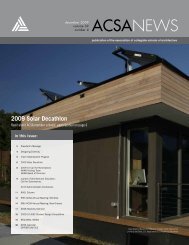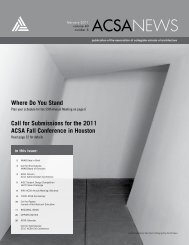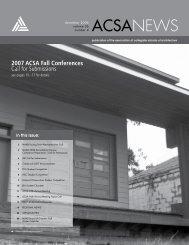digital aptitudes - Association of Collegiate Schools of Architecture
digital aptitudes - Association of Collegiate Schools of Architecture
digital aptitudes - Association of Collegiate Schools of Architecture
You also want an ePaper? Increase the reach of your titles
YUMPU automatically turns print PDFs into web optimized ePapers that Google loves.
SATURDAY, MARCH 3, 2012 - 12:30PM - 2:00PM<br />
Technology Continued<br />
surrounding trees, and creating ‘rooms’ with existing site features.<br />
The design <strong>of</strong> a computer based ‘system’ allows for continuous<br />
tweaking <strong>of</strong> the complex geometry throughout the design process<br />
- without having to remodel the form, for subsequent iterations.<br />
The overall form <strong>of</strong> the project can be manipulated through the development<br />
<strong>of</strong> a parametric system in the s<strong>of</strong>tware program Grasshopper.<br />
This allows variables such as the shape <strong>of</strong> the foot print,<br />
height <strong>of</strong> arches, and dimension and orientation <strong>of</strong> the oculi to be<br />
changed continuously throughout the design process.<br />
Once a parametric solution is selected - a series <strong>of</strong> control lines are<br />
output for each vault form. Following, a computer script - is run on<br />
the control lines, generating a triangulated frame based on a second<br />
series <strong>of</strong> variables including density <strong>of</strong> triangulation and pipe<br />
dimension. Also from these control lines the skin <strong>of</strong> the structure - a<br />
series <strong>of</strong> developable surfaces are produced.<br />
A physical model is used in conjunction with the computer model<br />
and s<strong>of</strong>tware to explore different patterning techniques <strong>of</strong> the<br />
structures skin - which will eventually be fabricated out <strong>of</strong> nylon<br />
sailcloth. A wire-frame armature <strong>of</strong> one <strong>of</strong> the vaults is constructed<br />
and used as a type <strong>of</strong> dress form. Variations <strong>of</strong> the covering are<br />
patterned sewn and fitted to the model.<br />
Molecular City<br />
Roberto Bottazzi, Royal College <strong>of</strong> Art<br />
Description:<br />
Molecular City is an installation presented at the 2010 Future Places<br />
Festival in Porto, Portugal. By taking advantage <strong>of</strong> Augmented<br />
Reality technology, it challenges the tenets <strong>of</strong> contemporary planning<br />
by collapsing real and virtual experience.<br />
Concept:<br />
As technology increases in computational power and user-friendliness,<br />
portable devices will be completely tuned in people’s needs<br />
and desires to their environment. The future <strong>of</strong> augmented reality<br />
technology [AR] will be urban. However, if fields as diverse as music<br />
or the military have already capitalised on such radical advancements,<br />
architecture and urbanism are still largely unaffected by this<br />
revolution. Architects still see themselves as the solitary creators<br />
<strong>of</strong> static physical objects seeking to single-handedly control urban<br />
experience.<br />
Molecular City challenges this outdated vision by speculating alternative<br />
modes <strong>of</strong> planning and experiencing the twenty-first century<br />
city.<br />
Similar to how simple molecules can be aggregated to form complex<br />
organic compounds such as proteins, Molecular City imagines<br />
a condition in which the overall complexity and richness <strong>of</strong> the urban<br />
experience is the result <strong>of</strong> a multitude <strong>of</strong> diverse narratives and<br />
singular gestures. The construction <strong>of</strong> such environment emphasises<br />
contingency and discontinuity over exactness and stability.<br />
By taking advantage <strong>of</strong> AR technology, Molecular City allows the<br />
public to create their collective hybrid city by superimposing<br />
virtual architectures onto the existing city <strong>of</strong> Porto via computer<br />
projection. The physical space <strong>of</strong> Porto becomes a canvas constantly<br />
connected to the endless possibilities provided by virtual<br />
space. The role <strong>of</strong> the architect recedes to the background; the<br />
city transforms into a gameboard where cultural desires and needs<br />
can be seamlessly projected and negotiated. Conflations <strong>of</strong> place,<br />
scale, emotion and history overlay to give rise to a hybrid (half real,<br />
half virtual) urban condition. A library <strong>of</strong> <strong>digital</strong> architectural models<br />
to play with will be provided via either ADS1 student models or<br />
free downlodable models from the Internet.<br />
Banking on the ongoing four-year research on the relation between<br />
<strong>digital</strong> technologies and urban environments, Roberto Bottazzi has<br />
a long experience in creative academic work that hybridise virtual<br />
and actual domains. Our most recent exhibition – at the Royal College<br />
<strong>of</strong> Art in February 2010 – utilised AR to invite the visitors to<br />
play with students’ work to compose their own landscape <strong>of</strong> projects.<br />
Performance-Based Generative Design<br />
Ming Tang, University <strong>of</strong> Cincinnati<br />
This project investigated a collaborative research and teaching<br />
project between the University <strong>of</strong> Cincinnati, Perkins+Will’s Tech<br />
Lab and nD group, and the University <strong>of</strong> North Carolina Greensboro.<br />
The primary investigation focuses on the design and fabrication<br />
<strong>of</strong> building components, derived from performance-based<br />
parameters. The project examines various approaches including<br />
theoretical investigations and proprietary s<strong>of</strong>tware tools for parametric<br />
design.<br />
The project first gives a short historical and philosophical background<br />
to performance-based design, then describes the technical<br />
and algorithmic requirements, and concludes with the examples <strong>of</strong><br />
implementation. With two design courses taught in 2011, the authors<br />
discuss the “shared body plan” as an essential element for<br />
applying generative form-seeking methods in architectural design.<br />
Design methodologies, such as use <strong>of</strong> building performance simulation<br />
tools, genetic morphing, and fitness evaluations are discussed<br />
as new paradigms in generative, performance-based design.<br />
This project also investigates how the large quantity <strong>of</strong> iterations<br />
can be filtered and selected based on the feasibility <strong>of</strong> fabrication<br />
and materialization processes. Using several student projects in the<br />
poster, the authors intend to demonstrate the methods <strong>of</strong> mass<br />
customization and parametric iteration through physical prototyping.<br />
The parameters related with fabrication have been implemented<br />
to generate a large quantity <strong>of</strong> creative solutions, whereas<br />
genetic algorithm functions are introduced as optimizers.<br />
As a conclusion, this poster illustrated the formation process that<br />
nature permits in order to sustain a generative system. The project<br />
analyzes several design and prototyping procedures, and illustrates<br />
how these performance-driven design approaches can be<br />
used for innovative forms, utilizing benefits <strong>of</strong> performance-based<br />
influences in architecture beyond formal assumption and aesthetic<br />
experimentation.<br />
Digital Apptitutes + Other Openings - Boston, MA - 57








